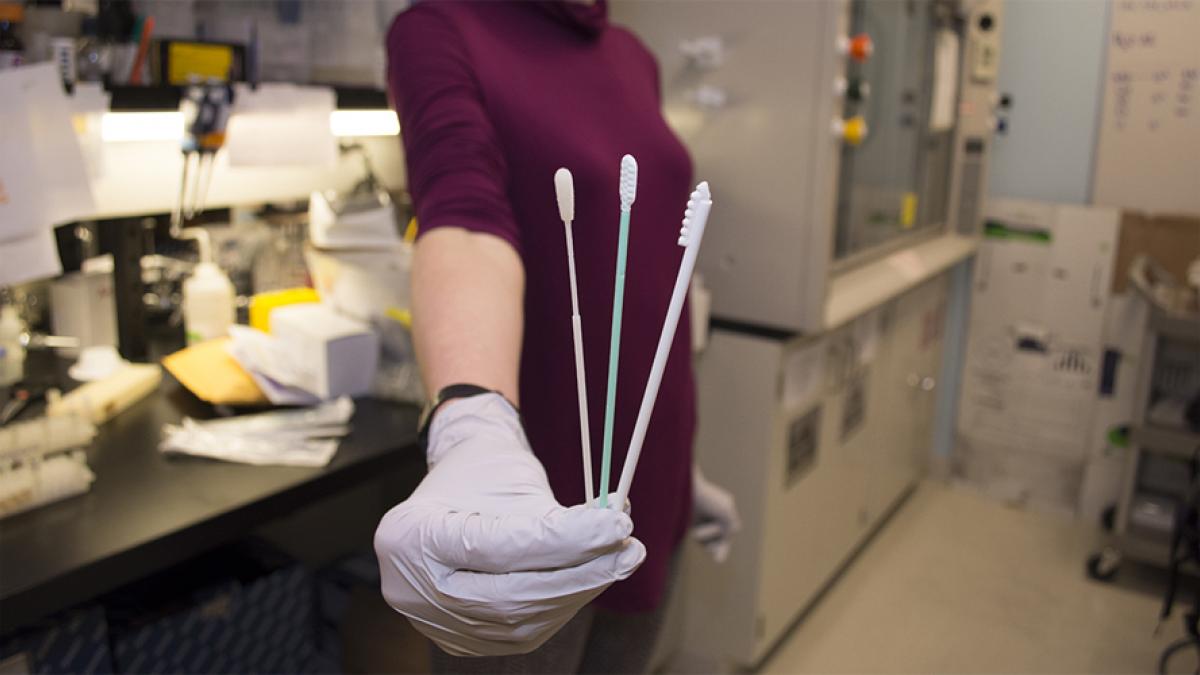
Objective: Through oral swab analysis (OSA), we seek to develop and validate an alternative sample type for diagnosing tuberculosis (TB). TB is commonly diagnosed by testing sputum, which patients cough up. This process can be hazardous to health care workers, and not everyone can produce sputum. Oral swabs, specifically, tongue swabs, are fast and easy to collect, and they can be collected from anyone, adults and children, regardless of whether they have symptoms. Because of this, OSA can also be used for active case finding.
Why it is important: Tuberculosis remains a global health threat - it is the leading cause of death from an infectious disease. In 2018, 10 million people developed TB infections and over 1.4 million died (Global TB Report, WHO, 2019). Improved diagnostics with samples that are easier to collect, and that can detect TB earlier are vital to stopping the spread of this disease.
Abstract: Oral swab analysis (OSA) has been shown to detect Mycobacterium tuberculosis (Mtb) DNA in the mouths of patients with pulmonary tuberculosis (TB), demonstrating its potential use as a diagnostic sample. In previous analyses, swab samples collected from the tongue correctly tested positive for TB in 93% of patients with TB diagnosed by analyzing sputum with GeneXpert. Alternative swab collection methods and devices, which are designed to collect more material from the tongue, may improve OSA so that more TB patients are correctly identified.
To test whether alternative swab collection methods and devices are collecting more material from the tongue, samples are analyzed using qPCR that amplifies the 16s gene universal to bacteria. This serves as a proxy for analyzing samples for Mtb. The swab brand or method that performs best is then used for collecting samples from patients with a possible TB infection. These samples are tested for Mtb using qPCR that targets a DNA sequence specific to Mtb.
We have found that even when 10 tongue swab samples are collected in quick succession from healthy volunteers, the amount of bacteria collected from the tongue does not diminish, indicating that multiple samples may be collected from patients in order to improve detection, and also that our preferred swab type does not collect all the bacteria that is present on the tongue. Copan FLOQswabs were found to collect two times as much bacteria from the tongue as our preferred swab, which can help to increase the likelihood that we will be able to detect Mtb in a sample from a patient with TB. In previous studies, we needed to collect 2 or 3 swabs per patient to detect Mtb in 90-93% of TB patients. However, by using the swab that has a greater capacity, we can detect Mtb in 88-95% of TB patients, collecting just one swab per patient. This represents a great improvement over our previous methods, but also indicates that there are more options to investigate to make further improvements. Additionally, we are exploring alternative methods for analyzing the tongue swab samples, so that we can obtain the results faster and in a greater variety of settings.
Partners: We partner with a number of researchers and institutions around the world, all of whom are essential to improving and validating OSA.
They include:
South African Tuberculosis Vaccine Initiative, University of Cape Town, South Africa
iLEAD, Johannesburg,South Africa
Global Health Labs, Bellevue, WA, USA
Department of Biomedical Engineering, Northwestern University, USA
Clinical Mycobacteriology and Epidemiology Group, Stellenbosch University, South Africa
QuantuMDx Group, United Kingdom
Other University of Washington research groups in the School of Medicine, Department of Global Health, Department of Bioengineering,
The Yager Lab, University of Washington Department of Biomedical Engineering
Paul Drain and Adrienne Shapiro in Department of Global Health at the University of Washington
Adithya Cattamanchi at UCSF
FIND Diagnostics
Alfred Andama at Makerere University in Kampala, Uganda
Oasis Diagnostics in Portland Oregon
Funders:
Bill & Melinda Gates Foundation
National Institute of Health
National Institute of Allergy and Infectious Diseases
National Institute of Biomedical Imaging and Bioengineering
Current Status: We are currently engaged in research in the following key areas:
Improving OSA methodology - to achieve this, we are investigating a variety of different swab products and tongue scrapers. We are also looking at sample collection protocols, storage buffers that eliminate the cold chain, and sample analysis methods that can facilitate integration with point-of-care (POC) and other rapid, automated technologies, like the Cepheid GeneXpert. Exploring factors related to OSA positivity in certain patients, such as the presence of certain comorbidities. Developing methods to test for multiple diseases from a single swab sample, in particular, TB and COVID-19.
Current Evidence: Currently, our recommended method for OSA involves using a Copan regular FLOQswab, collected by swabbing the tongue dorsum for 10 seconds and analyzed using a manual qPCR targeting the IS6110 sequence. With this, we are able to achieve 88-94% sensitivity relative sputum GeneXpert.
Publications:
- Preferences of health care workers using tongue swabs for tuberculosis diagnosis during COVID-19
- Complementary Nonsputum Diagnostic Testing for Tuberculosis in People with HIV Using Oral Swab PCR and Urine Lipoarabinomannan Detection
- Accuracy of Tongue Swab Testing Using Xpert MTB-RIF Ultra for Tuberculosis Diagnosis
Swabs Collected by Patients or Health Care Workers for SARS-CoV-2 Testing
Detection of Mycobacterium tuberculosis DNA on the oral mucosa of tuberculosis patients
Next steps: Our next steps are to determine whether both TB and COVID-19 can be detected from a single swab, to continue improving OSA methodology to facilitate more efficient sample collection and testing, and to further validate OSA in new populations and regions so as to better address patient needs.
Who is working on it:
Gerard Cangelosi, PhD, Principal Investigator
Kris Weigel, Research Scientist
Rachel Wood, MS, Research Scientist
Alaina Olson, Research Assistant
Ethan Valinetz, MD, Graduate Student
Renee Codsi, Graduate Student
Grant Whitman, Graduate Student
Divya Naidoo, Research Assistant
Claire Yang, Undergraduate Student